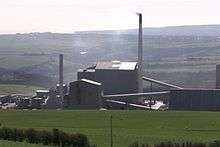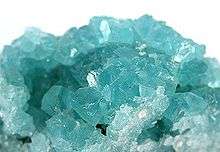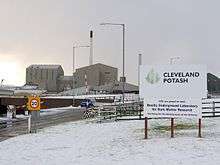Boulby Mine



Boulby Mine is a 200-hectare (490-acre) site located just south-east of the village of Boulby, on the north-east coast of the North York Moors in Redcar and Cleveland, England. It is run by Cleveland Potash Limited, which is now a subsidiary of Israel Chemicals Ltd.
It produces half of the UK's output of potash, an agricultural fertiliser. The mined ore consists of 35–45% sylvite ("potash", specifically potassium chloride) and 45–55% halite (rock salt, or sodium chloride).[1] The rock salt is extracted as a by-product and used across the region as a de-icing agent on roads in winter conditions.
The mine has 1,001 employees[2] and can produce up to one million tonnes of potash each year.[3] At 1,400 metres (4,600 ft) deep, it is the second deepest mine of any kind in Europe, and has a network of underground roads extending under the North Sea, totalling 1,000 kilometres (620 mi) in length.[4]
Cleveland Potash Limited had a reported turnover of £194 million in 2013, up from £162 million the year before. However, despite the increased turnover, the company suffered a total pre-tax loss of £194 million. This was the result of a huge £200 million impairment charge arising from a significant fall in potash prices.[2]
History
In 1939, potash was discovered in the area at Aislaby when prospectors were drilling to look for oil. The reserves were investigated in the 1950s but appeared too deep to exploit economically. Solution mining was considered from 1962, but not pursued.[5]
Imperial Chemical Industries (ICI) began construction on the mine in 1969, and started producing potash in 1973. The mine was the source of all of the UK's home-produced potash – around 55 percent of the total UK market. It occurs between 1.2 kilometres (0.75 mi) and 1.5 kilometres (0.93 mi) below ground and has an average seam thickness of 7 metres (23 ft). It took until 1984 for the mine to achieve profitability.[1]
ICI formed Cleveland Potash Limited jointly with Anglo American, and later sold it to them, who in turn divested it to Israel Chemicals Ltd in 2002.[6]
In April 2011, the mine began the world’s first commercial production of polyhalite, a rare mineral that has been found in large quantities in a seam out to sea from the mine, with total resources estimated at over a billion tonnes lying more than 1.5 kilometres offshore. The mineral has a commercial potential as an inorganic fertiliser.[7]
In April 2014, Cleveland Potash was awarded a £4.9 million government grant to support the mining of polyhalite at the Boulby site[8] and parent company Israel Chemicals Ltd (ICL) has pledged to invest £300 million in the area before 2018.
Plans include extending the mine to the east and upgrading facilities to increase production capacity. Environmental groups have raised concerns that the development could have an intrusive effect on the local area.[9]
Transport
Much of the output from the mine is transported by rail, as the site is located south of Loftus along the route of the former WRMU (Whitby Redcar and Middlesbrough Union Railway), which was closed on 5 May 1958. Today the line is open from Saltburn to Boulby for goods traffic only. Teesport handles most of the bulk cargo export from the mine, via a specific potash and rock salt terminal.
Underground laboratory

Because of its depth, Boulby Mine is the site of the Boulby Underground Laboratory 1,100 metres below the surface (2800 metre water equivalent). Early experiments (now completed) include the UK Dark Matter Collaboration.[10] and ZEPLIN-III. Current experiments[11] include the Directional Recoil Identification From Tracks experiment's DRIFT-IIb detecor. A low pressure negative ion time projection chamber (NITPC) designed to detect weakly interacting massive particles (WIMPs, a prime dark matter candidate), a second detector (DRIFT-IIc) is located on the surface at Occidental College, Los Angeles, California, USA.[10]
Work is being carried out at the underground laboratory by the UK Centre for Astrobiology to study extremophile organisms that can survive in a salt-rich environment.[12] The site is also used for testing NASA Mars rovers.
Health and safety
In June 2014, an employment tribunal revealed that the Boulby mine would have been unable to cope in an emergency. Former Rescue Team Coordinator Stephen Angus was fired after failing to ensure enough safety officers were trained to respond. He was also accused of failing to maintain the required standard of breathing apparatus.[13]
Cleveland Potash Limited has been served with 11 notices for breaches of health and safety procedures by the Health and Safety Executive since 2012.[14] They include not taking appropriate measures to protect workers from the risks of explosion, falling ground and inadvertent entry into the mine shaft.
In April 2014 there was a collapse at the mine caused by a falling boulder.[15] In 2012 a 50-year-old man was airlifted to hospital after suffering chest injuries when a hose burst and forced him against a skip.[16] In 2007, 24-year-old miner Darren Compton was killed by falling rock. He had been operating equipment supporting a sidewall in a recently mined roadway.[17]
In the early hours of 17 June 2016, popular miner 55-year-old John Anderson, Richie to his friends and family, was killed in a "gas blow-out" while working in the mine.[18]
See also
- Winsford – home of Britain's largest rock salt mine
References
- 1 2 "Boulby, United Kingdom", Mining-technology.com, Progressive Digital Media Group PLC. Retrieved 11 November 2014
- 1 2 "Cleveland Potash Continues Investment After Turnover Growth". 13 October 2013. Retrieved 18 November 2013.
- ↑ "Huge grant just the job at Boulby". Whitby Gazette. 15 April 2011.
- ↑ Inside the potash mine one mile under the North Sea, BBC News, 24 April 2013.
- ↑ Paul Sowan. "Boulby Potash Mine – a site visit". Subterranea Britannica. Retrieved 27 April 2013.
- ↑ ICL Fertilizers. "Boulby Potash Mine, United Kingdom" (PDF). mine-explorer.co.uk. Retrieved 27 April 2013.
- ↑ "A new mineral and new jobs at Boulby mine". The Guardian. 12 April 2011.
- ↑ “news article” BBC News http://www.bbc.co.uk/news/uk-england-tees-26960911 10 April 2014 Retrieved 18 November 2014
- ↑ “news article” BBC News http://www.bbc.co.uk/news/uk-england-tees-22152699 16 April 2013 Retrieved 18 November 2014.
- 1 2 "Boulby Underground Laboratory". Science & Technology Facilities Council.
- ↑ Paling, Sean (21 July 2016). Boulby Underground Laboratory: Status and plans. Identification of Dark Matter 2016. Sheffield.
- ↑ Rebecca Morelle (7 August 2013). "Boulby mine: Underground life gives alien clues". BBC News.
- ↑ source “News article” http://www.gazettelive.co.uk/news/stephen-angus-sacked-cleveland-potash-7215067 4 June 2014 Retrieved 18 November 2014
- ↑ source “Health and Safety Executive” http://www.hse.gov.uk/notices/notices/notice_list.asp?PN=1&ST=N&rdoNType=&NT=&SN=F&x=36&EO=LIKE&SF=RN&SV=cleveland+potash&y=13&SO=DNIS retrieved 18 November 2014
- ↑ source “News article” http://www.gazettelive.co.uk/news/teesside-news/probe-after-collapse-deep-under-6686166 By Dave Robson 8 February 2014 Retrieved 18 November 2014
- ↑ source “News channel” BBC News http://www.bbc.co.uk/news/uk-england-york-north-yorkshire-16627511 19 January 2012 Retrieved 18 November 2014
- ↑ source “News article” Northern Echo http://www.thenorthernecho.co.uk/news/1346124.probe_into_potash_mine_tragedy/ 21 April 2007 Retrieved 18 November 2014
- ↑ source "News channel" ITV News http://www.itv.com/news/tyne-tees/update/2016-06-17/identity-of-boulby-mine-death-victim-revealed/ 17 June 2016 Retrieved 17 June 2016
External links
 Media related to Boulby Potash Mine at Wikimedia Commons
Media related to Boulby Potash Mine at Wikimedia Commons- ICL UK - official website.
- Discovery Channel video from How Do They Do It?
- Boulby Potash Mine NZ761183, images at UK mine exploration website
Coordinates: 54°33′12″N 0°49′28″W / 54.5534°N 0.8245°W